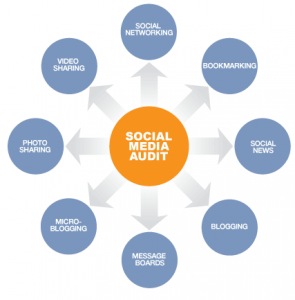 When teaching public relations, marketing communications or branding in a social media context, I have discovered that using social media audit exercises will provide students with a combo of analysis, analytics and strategy.
When teaching public relations, marketing communications or branding in a social media context, I have discovered that using social media audit exercises will provide students with a combo of analysis, analytics and strategy.
When performed by communication companies or consultancies, the social media audit is used as a means appraising where the company is currently situated (as in what platforms they use and how) so that strategic decision that match the company’s positioning with the platforms and channels it uses can be taken. For some, a social media audit is a simple review of what a company does (if anything with social media). For others like Tamar Weinberg of Mashable or Kristy Bolsinger of Social Fresh a social media audit entails a more in-depth analysis that touches on branding, integration, content and measurement.
However, for the courses I teach in Belgium for instance both Tamar’s and Kristy’s lists are too detailed and cannot be implemented during the 3-hours of class time that I usually have available.
Social Media Audit for Public Relations Classes
For instance, for the New Media course we use a basic social media audit exercise through which the students can compare whether the mission and vision communicated by a company through their official website is coherent with the one they convey through their social media channels. Observing consistency and coherence in communication is represents the fundamental goal of the exercise. Based on their observations, students need to formulate recommendations for the companies studied. Examples of how Erasmus exchange students have completed this exercise are available here and here.
Instructions:
1. Google the name of the company (list the information and links about the company you find and indicate their position in the results)
OR
- Go to the company website
- Identify the mission and vision of the company. What are the company’s key messages?
- Identify the audience of the company through assumptions and observations of the website landing page
- identify whether the company has any visible social media links on display on the main website (in the form of links, buttons or embeds to social networking, social bookmarking, professional networking, media sharing sites…)
- Check out the social media presences of the company that you identified and compare their use with the general mission and vision of the company (For Twitter look at the account bio, the followers, follows, list ratio and the structure of the messages – tweets, RTs, mentions and#; For Facebook look at the page presentation, the number of likes and fans and the structure of the wall; For YouTube is it an account or a channel, check the subscribers, responses…)
- Identify the audiences the company is targeting via social media and compare them with the audience of the company website
- Perform a more in-depth analysis of twitter using reach and influence scores as well as metrics about the company’s account activity (go to TweetStats.com to identify tweeting patterns (do they reflect what you directly observed on twitter/go to TwitAlyzer.com to check the account’s influence score/go to TweetRank.com to identify the account’s potential reach/go to Archivist.Visitmix.com to verify TweetStats and TwitAlyzer data + gain more info on tweeting platforms)
- Compare results
- Make recommendations or an improved online communication strategy (if needed) based on previous observations.
Branding & Branding Equity seen through a brand touch point
For the Branding class at Katho we used a similar exercise yet the data we looked at was analyzed from a branding perspective. In this case students were given a brand and had to first assess its image (as in their perception of the brand). Then, they were given an online brand touch point (website, facebook page or twitter account) and had to analyze the brand’s image using that given gateway.
For the website and facebook presences the analyses follow Tamar and Kristy’s structures – as in focus on mission, vision, brand image and brand elements (logo, background, typography, visual identity) consistency.
Instructions:
For Twitter, since there are more tools that scrape data and provide descriptive statistics we used the following:
- Check out Twitter account (observe account bio, the followers, follows, list ratio and the structure of the messages – tweets, RTs, mentions and)
- Go to Twitter Network and analyze the account’s network (is it well connected with other accounts or not, is it’s network interconnected…)
- Go to TwitterGrader to assess the account’s influence score (alternative TwitAlyzer or Twinfluence)
- Go to Twitter Sentiment and Social Mention and compare the positive/negative mentions ratio of the brand/account. Analyze (qualitatively) the messages about the brand and identify associations with the brand. Are the tools correctly assessing positive/negative sentiment. Add depth to the analysis separating tweets based on their references to price, performance or quality of brand/product.
Should you decide to use these exercises, please let me know and let me know how your students find them. Similarly, if you have other ideas, please share them below.



Pingback:Quora